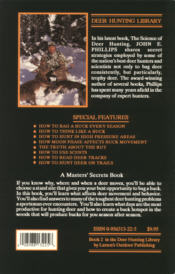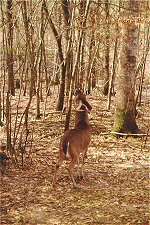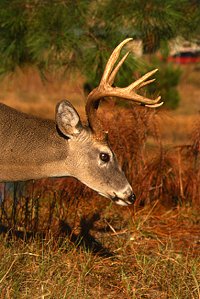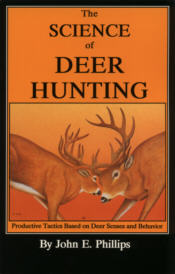
|
Features
|
|
|
|
Book Selections
|
|
Fun & Games
|
|
Contact Us
|
| Click on Images to Enlarge |
 |
CHAPTER 10
WHY NUTS ARE THE BEST BET FOR BUCKS
Double And Triple Dip Nut Trees
According to Hawkins, deer will feed under the same nut trees at three different times of the year. Hawkins has observed that when a tree first drops its nuts, the deer will concentrate under that tree. But they often will leave that tree or group of trees when nuts are more abundant under another tree. This first dropping of the nuts represents the first time the deer feed under these trees.
The second time the deer will come to these same trees is after all the trees have dropped their nuts. Then the animals return to feed on many of the same trees they have fed under when that particular tree first has dropped its nuts. They also will have to look harder to find more nuts. During this second feeding cycle, the deer do not concentrate on one particular tree as they do when that tree first drops its nuts. But they will return to many of the trees they have fed under during the first of the season to try and find additional nuts later in the season. Rarely will deer find all the nuts under a tree during the first or second feeding cycle.
Then later on in the year if heavy rains pour into a woodlot, the acorns that are left under those same trees will float to the surface, wash into low spots and puddles and concentrate like caches of gold nuggets in a pocket of a stream. After the water subsides, the deer will search for these small pockets of acorns and feed heavily on them.
"If an area has a flood, the acorns will float to the surface and wash into eddy holes," Hawkins explained. "The deer actually will move out into the water and feed on the acorns there. During high water if you can find a line of acorns along the edge of flooded timber, you'll often see deer moving along this line and feeding on the acorns on the edge of the water."
 REALIZE
NUTS ARE A RELIABLE HUNT SITE
REALIZE
NUTS ARE A RELIABLE HUNT SITE
Deer do not read magazine articles or solunar tables. They move and feed whenever they want to and not only early in the morning and in the late afternoon. During the rut, bucks will feed all during the day. When hunting pressure is high, they may eat in the middle of the day. When you are hunting under a nut tree, you can expect to see a buck at any time of the day. Nuts are the natural browse whitetails feed on whenever available.
RECOGNIZE A HONEY HOLE NUT TREE
According to Hawkins, certain nut trees hold secrets to bagging bucks.
"When most hunters see an oak tree standing alone in the middle of a clearcut, they won't bother to go to that lone nut tree and try and hunt near it, and why should they? Plenty of areas have numerous nut trees. But what they often fail to realize is an isolated oak tree that is producing nuts in a clearcut will provide a food source for deer in thick cover where they are protected and may concentrate deer in that one spot better than a large group of nut trees will in a woodlot with other nut trees."
 Hawkins
also searches for acorn trees in pine plantations.
Hawkins
also searches for acorn trees in pine plantations.
"Oftentimes a red oak or a white oak tree will stand on the edge of a firebreak, along a gully or a ditch or in a turn-around spot in the middle of a pine plantation," Hawkins mentioned. "This nut tree will provide food in thick cover areas and can and will concentrate bucks."
Another honey hole nut tree may be an acorn tree surrounded by a briar thicket or a tree on the edge of a patch of cane near a river or a creek bank.
"Any place where you find a producing acorn tree close to thick cover, you often will find a deer feeding site," Hawkins reported. "Mature bucks like to remain in thick cover during hunting season. If they only have to move a yard or two out of that thick cover to feed, then they may hit those acorn trees on the edge of thick cover during daylight hours. If during hunting season, the acorn trees are out in open woods the bucks still will feed on them. However, most of the time they will eat on these nuts after dark."
If you plan to hunt big bucks around acorns, look for thick cover corridors the bucks can use to reach these trees without exposing themselves in the open woods. These acorn trees may provide the best opportunity for you to bag a buck this season.
|
How To Order CALL or Send check or money order to: Night Hawk Publications *All Alaskan orders add $8 for each book ordered. *All Canadian orders add $3 for each book ordered and use International
Money Order |

